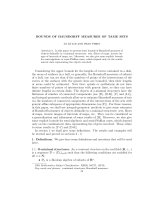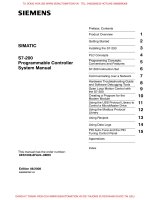sha541 glossary en us v2
Bạn đang xem bản rút gọn của tài liệu. Xem và tải ngay bản đầy đủ của tài liệu tại đây (176.8 KB, 4 trang )
SHA541:
Price
and
Inventory
Controls
School
of
Hotel
Administration,
Cornell
University
G lossary
Break-even
The
point
at
which
revenues
equal
costs.
Closed to arrival (CTA)
A
type
of
availability
control
that
does
not
allow
new
reservations
to
be
taken
for
guests
arriving
on
this
date.
The
only
guests
that
are
using
inventory
will
be
those
arriving
on
earlier
dates
and
staying
over
on
the
said
date.
Cold period
A
period
(a
season,
month,
day,
or
time
of
day)
when
operating
performance
(demand)
is
low.
From
the
perspective
of
hotel
revenue
management,
cold
periods
are
times
when
discounted
rates
and
incentives
can
be
used
to
try
to
increase
occupancy
and
improve
RevPAR.
Demand-based pricing
A
pricing
strategy
that
sets
higher
prices
for
periods
of
high
demand
and
lower
prices
for
periods
of
low
demand.
Elastic demand
A
result
of
higher
competition,
standardized
services
or
luxury
good
nature.
When
demand
is
elastic,
consumers
are
more
responsive
to
price
changes.
Expected marginal revenue (EMR)
The
estimate
of
marginal
value
given
that
demand
is
uncertain.
EMR
is
the
revenue
multiplied
by
the
probability
that
we
sell
the
unit
(probability
that
demand
is
greater
than
or
equal
too
our
supply).
Revenue
×
Probability
of
selling
=
EMR
1
© 2015 eCornell. All rights reserved. All other copyrights, trademarks, trade names, and logos are the sole property of their respective owners.
SHA541:
Price
and
Inventory
Controls
School
of
Hotel
Administration,
Cornell
University
Fixed capacity
Inventory
available–number
of
hotel
rooms,
seats
on
plane,
etc.–owing
to
the
nature
of
these
businesses,
the
number
of
units
that
can
be
sold
is
a
fixed
number;
when
they
are
all
sold,
there
is
no
more
capacity.
Fixed pricing
A
pricing
strategy
that
does
not
vary
prices
according
to
demand,
product
characteristics,
or
segmentation
of
markets.
Forecast
In
revenue
management,
an
estimate
of
the
number
of
rooms/seats/rental
cars
that
will
be
sold
for
use
on
some
future
date.
Accurate
forecasting
makes
it
possible
to
employ
the
strategies
of
revenue
management
appropriately,
according
to
the
expected
level
of
demand.
Hot period
A
period
(a
season,
month,
day,
or
time
of
day)
when
operating
performance
(demand)
is
strong.
From
the
perspective
of
revenue
management,
a
hot
period
is
when
rates
can
be
set
higher
and
length-‐of-‐stay
controls
can
be
used
to
improve
RevPAR.
Inelastic demand
A
result
of
low
competition,
highly
differentiated
services,
or
consumer
staples.
When
demand
is
inelastic,
consumers
are
unresponsive
to
changes
in
the
price
of
a
product
or
service.
Length-of-stay controls
All
controls–internal
and
external–that
regulate
duration
of
use.
Marginal value
The
incremental
value
of
one
additional
unit–the
value
of
having
one
more
(or
less)
room.
Also
referred
to
as
Shadow
price
in
the
simultaneous
decision
making
(SDM)
framework.
2
© 2015 eCornell. All rights reserved. All other copyrights, trademarks, trade names, and logos are the sole property of their respective owners.
SHA541:
Price
and
Inventory
Controls
School
of
Hotel
Administration,
Cornell
University
Overbooking
The
practice
of
accepting
reservations
beyond
capacity
in
order
to
compensate
for
cancellations
and
no-‐shows.
Overbooking
is
an
essential
element
of
revenue
management.
Perishable inventory
Inventory,
that
if
not
used
within
a
timeframe,
is
lost
revenue
opportunity.
Price discrimination
An
approach
to
pricing
that
introduces
variations
in
price
not
associated
with
differences
in
the
quality
of
the
product
or
service
nor
with
the
cost
of
production.
Rate fence
A
tactic
used
to
segment
customers
into
market
groups
based
on
their
willingness
to
pay,
their
purchasing
behavior,
or
their
needs.
In
revenue
management,
the
following
rate
fences
may
be
used
as
part
of
a
variable-‐pricing
strategy:
physical
rate
fences
(location,
view,
amenities),
product-‐line
rate
fences
(top
of
the
line
vs.
bargain),
controlled-‐availability
rate
fences
(coupons,
those
who
ask),
and
buyer-‐characteristics
rate
fences
(seniors,
kids,
group
membership).
Reference price
The
price
customers
think
a
service
(or
product)
should
cost.
Reference
prices
may
be
based
on
the
price
last
paid,
the
price
most
frequently
paid,
the
price
other
customers
say
they
paid
for
similar
offerings,
or
on
market
prices
and
posted
prices.
RevPAR
Revenue
per
available
room-‐night.
This
hotel-‐specific
variation
of
RevPATI
can
be
calculated
in
two
ways:
a)
by
dividing
the
total
nightly
room
revenue
by
the
number
of
rooms
available
or
b)
by
multiplying
the
average
room
rate
by
the
actual
percentage
of
occupancy
on
a
given
night.
This
measure
is
used
in
revenue
management
to
analyze
a
business's
ability
to
utilize
its
revenue
capacity.
3
© 2015 eCornell. All rights reserved. All other copyrights, trademarks, trade names, and logos are the sole property of their respective owners.
SHA541:
Price
and
Inventory
Controls
School
of
Hotel
Administration,
Cornell
University
RevPATI
Revenue
per
available
time-‐based
inventory
unit.
RevPAR
and
RevPASH
are
industry-‐
specific
variations
on
this
all-‐inclusive
measure,
which
is
calculated
differently
in
different
contexts
and
is
used
in
all
applications
of
revenue
management
to
analyze
a
business's
ability
to
maximize
its
revenue
capacity.
Segmentable markets
Markets
composed
of
heterogeneous
customers
–
customers
that
can
be
separated
into
various
classes,
differentiated
by
how
much
they
are
willing
to
pay
for
a
product
or
service,
by
age,
by
frequency
of
purchase,
or
by
affiliation
with
potentially
profitable
groups.
Simultaneous decision-making (SDM)
A
modeling
approach
for
settings
where
prior
decisions
affect
the
outcomes
of
current
decisions,
and
therefore
decisions
are
best
made
simultaneously
rather
than
sequentially.
Time-variable demand
Uncertain
demand
that
varies
temporally
by
time
of
year,
day-‐of-‐week,
time
of
day,
etc.
Unconstrained demand
A
measure
of
the
demand
for
a
particular
service
or
product
that
is
the
sum
of
all
consumers
who
have
purchased
or
would
purchase
that
product
at
a
particular
time.
"Unconstrained"
refers
to
the
elimination
(in
theory)
of
the
constraint
of
availability.
Warm period
A
period
(a
season,
month,
day,
or
time
of
day)
when
demand
is
neither
high
nor
low.
4
© 2015 eCornell. All rights reserved. All other copyrights, trademarks, trade names, and logos are the sole property of their respective owners.









